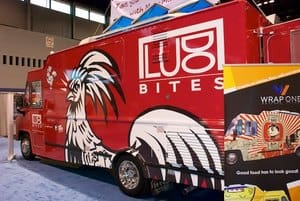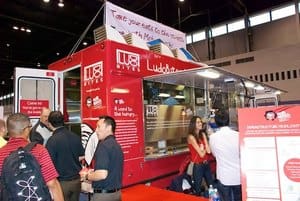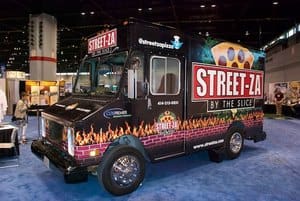

When the first slide says, ‘Welcome to the Revolution,’ and the numbers filling the room are beginning to threaten Fire Code limitations, you know it might be a big deal.
That’s the scenario found at the “National Restaurant Association”:www.restaurant.org’s seminar on street trucks. Sure, we knew they were big—we’ve been telling you about them for a long time. But now they are going mainstream.
The panelists, were Ludo Lefebvre, called the ‘King of pop-up restaurants in L.A.’, Aaron Noveshen, from The Culinary Edge, Mary Sue Millikin of Border Grill & Truck in L.A., Matthew Geller, CEO of SoCal Mobile Food Venders Association, Tiffany Kurtz, of Chicago’s Flirty Cupcakes, with moderation by Ray Villaman, President of Mobi Munch, Inc..
‘Rarely do we have anything this game-changing,’ started Villaman. And the crowd agreed—a good percentage of them said they were considering adding their own ‘gourmet mobile food trucks’ in conjunction with their restaurants.
So, before we go on, a few definitions of terms:
⋅ Pop-up restaurants are restaurants that open for a limited amount of time in other businesses’ premises. Born out of the problems of the economy (rent, overhead, lack of time off) they answered a bunch of questions quickly.
⋅ Street trucks are usually construction vans that were actually used for construction in better days—when the economy tanked, those tanks were left unused until someone had the bright idea to do a taco truck.
⋅ Gourmet mobile food trucks are simply a way of differentiating the term from the old vender carts, serving hot dogs or bar-be-que, or from memories of the ice cream truck running through your neighborhood. Gourmet trucks may not really be gourmet food, but they are higher end out of, well, a truck.
⋅ Twitter is the social media mechanism most often used to alert followers of a truck’s location, specials, or food quantities. Wouldn’t want them to run out before you find them!
⋅ Commissary, in the food truck world, means a place to park, clean your vehicle, get ice, plug in for power, and get rid of wastewater.
As for why these trucks are suddenly so popular, Villaman ran down this list:
⋅ Economic downtown
⋅ Inventory of old trucks
⋅ Increasing pool of culinary talent
⋅ Increasing public interest in food culture
⋅ Lack of capital for brick & mortar building
⋅ Increasing demand for convenient, affordable, high quality food
⋅ Millennial Generations’ impact on values, attitudes and lifestyles
The panelists talked about their own experiences in building the clientele for mobile dining and why the do it.
Said Milliken, ‘There are places, like Little League games, where people are sort of held hostage. We can take them a healthy, affordable solution.’
The whole thing is a new venture for Lefebvre, who said, ‘All my life I worked in fine dining rooms, and I’m bored. I really want to cook for everybody, not just rich people. As a chef, my job is to feed people. I want to feed everybody. Plus,’ he added with a smile, ‘I can change a concept in a month!’ Lefebvre’s truck, by the way, is a fried chicken truck simply because, he said, ‘I love, love, love, love fried chicken!’
Kurtz, who talked about the challenges of licensing her business when Chicago didn’t allow hot food trucks, emphasized that she doesn’t bake from the truck. And, she said that the whole point was about marketing: ‘I have been so amazed,’ she said. ‘I knew that for something happening in real time, I needed real time marketing.’
That’s where Twitter comes in for all of these entrepreneurs, including Lefebvre, who speaks with a heavy French accent. ‘Twitter is perfect for me,’ he said, ‘because everybody understands me!’

Other advice from the panel included making lunch your starting point, but parking near a bar late at night, and recognizing that this is all about mobility. ‘In fine dining, they might take three or four hours to eat,’ said Lefebvre. ‘Now people eat in 10-15 minutes.’
While they all identified challenges (ever try to find a parking space that wasn’t near an established restaurant?), Noveshen said, ‘It’s about having fun, escaping your day, eating delicious food, connecting with people.’
Bring on the Revolution.
_Also see our story about Streetza Pizza.

